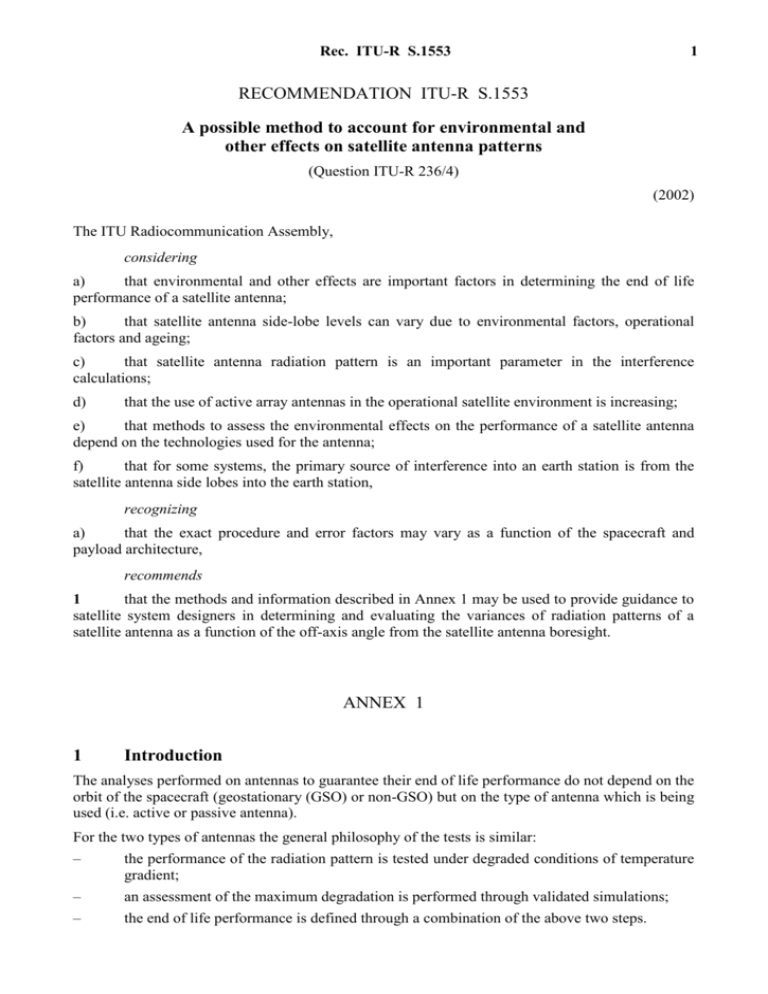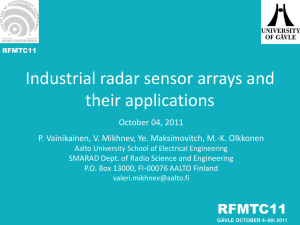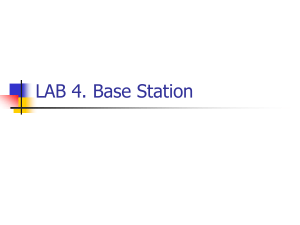Word - ITU
advertisement

Rec. ITU-R S.1553 1 RECOMMENDATION ITU-R S.1553 A possible method to account for environmental and other effects on satellite antenna patterns (Question ITU-R 236/4) (2002) The ITU Radiocommunication Assembly, considering a) that environmental and other effects are important factors in determining the end of life performance of a satellite antenna; b) that satellite antenna side-lobe levels can vary due to environmental factors, operational factors and ageing; c) that satellite antenna radiation pattern is an important parameter in the interference calculations; d) that the use of active array antennas in the operational satellite environment is increasing; e) that methods to assess the environmental effects on the performance of a satellite antenna depend on the technologies used for the antenna; f) that for some systems, the primary source of interference into an earth station is from the satellite antenna side lobes into the earth station, recognizing a) that the exact procedure and error factors may vary as a function of the spacecraft and payload architecture, recommends 1 that the methods and information described in Annex 1 may be used to provide guidance to satellite system designers in determining and evaluating the variances of radiation patterns of a satellite antenna as a function of the off-axis angle from the satellite antenna boresight. ANNEX 1 1 Introduction The analyses performed on antennas to guarantee their end of life performance do not depend on the orbit of the spacecraft (geostationary (GSO) or non-GSO) but on the type of antenna which is being used (i.e. active or passive antenna). For the two types of antennas the general philosophy of the tests is similar: – the performance of the radiation pattern is tested under degraded conditions of temperature gradient; – an assessment of the maximum degradation is performed through validated simulations; – the end of life performance is defined through a combination of the above two steps. 2 Rec. ITU-R S.1553 This Annex provides some details on this general approach of antenna performance assessment. Terminology used in the antenna descriptions is as follows: – a passive antenna is an antenna for which the radiating component does not include any active equipment (like solid state power amplifier (SSPA), low noise amplifier (LNA), travelling wave amplifier (TWA)). The amplification is centralized and is part of the repeater. The passive antenna is the most commonly used type of antenna. The passive antenna can be linked to a pointing mechanism in order to permit mobile coverage; – the active antenna is a subsystem in which the active elements are integrated in between the radiating elements of the beam forming network. This technology allows the generation of reconfigurable multiple beams. One of the fundamental principles of active antenna theory is that the radiation pattern is determined by the amplitude and phase distribution across the aperture. The antenna designer can, in principle, optimize the illumination laws and expect the resulting radiation pattern to be as predicted. In practice, however, there will be unavoidable errors and the actual radiation pattern will differ to some extent from the theoretical one. 2 Passive antennas Main passive antenna architectures are based on reflector antennas, i.e. a parabolic reflector illuminated by a primary feed or subreflector located at/near the main reflector focus. Then the antenna radiated performances are affected by mechanical and thermal distortions which will mainly lead to a slight change of the reflector shape and then affect the illumination laws. Those mechanical and thermal distortions appear at two stages: – during reflector manufacturing: the manufactured surface will differ from the theoretical one; – during antenna life: the satellite environment results in certain mechanical and thermal distortions which impact on the antenna geometry and then its radiated performance. These effects will result in an increase of the side-lobe levels, a reduction in the on-axis gain and, at a lower level, an error in the direction of the main beam. The errors coming from mechanical and thermal distortion are predictable, and the resulting radiation pattern can be computed by classical methods from the knowledge of the mission, the satellite architecture and the antenna configuration. Once the antenna configuration has been designed the different steps of the analysis to guarantee the end of life performance are the following: – characterization of manufacturing errors with respect to theoretical shape (a root mean square (rms) deviation is derived); – revision of the antenna model taking into account these errors; – measurement of antenna radiated performance at ambient temperature and correlation with modelling; Rec. ITU-R S.1553 3 – research into the thermal and mechanical environments which lead to worst antenna distortion (worst rms distortion); – prediction of end of life antenna pattern by analysis. The performance parameters which are tested at ambient temperature shall show margins with respect to the specification and the analysis listed last in the above list is used to confirm that these margins are sufficient to guarantee the performance until the expected end of life. 3 Active antennas The evaluation or prediction of the performance of array antennas in the presence of elemental excitation variations (due to environmental and operational factors including failures) is an important part of the engineering effort in the development of high-performance antennas for in-orbit operation. As part of the engineering process error budgets are compiled to define the performance of the antenna over the life of the satellite. An active antenna radiation pattern will differ from the theoretical pattern because of dispersion of the characteristics between active chains which create a distortion of the amplitude and phase illumination laws, these distortions are commonly called A/ errors. Different types of errors can be described. Errors can be divided into two types depending on whether they are predictable or random. – Predictable errors (such as reproducibility, assembly and thermal gradient defaults) can be compensated by antenna calibration at calibration points (frequency and/or temperature) at equipment level. Dispersion of these errors over the frequency range and/or the temperature range will not be compensated and will then be part of the A/ budget. – Random errors are caused by the accidental deviations of the antenna parameters from their design value. These deviations will occur at the beginning of life (due to characteristic dispersions of each and between equipments) and will change throughout the antenna life to finally give the end of life antenna performance. Although they may be small they will affect the antenna main beam and side-lobe gain performance. The three following items in the A/ analysis can be identified: – A/ calibration error at calibration points; – A/ dispersions over the frequency range and/or the temperature range; – A/ dispersions over life. These three items combined in a statistical analysis will be used: – to compare measured patterns to theoretical antenna patterns at a reduced set of test conditions (ambient temperature, some frequency points, …); – to confirm that the margins (with regard to the specifications) shown for the reduced set of test conditions are large enough to guarantee the performance during the satellite lifetime. This section identifies parameters that affect antenna performance and provides a method for estimating the antenna side lobe variance for each pointing direction. This variance can then be used to calculate an antenna gain pattern that will not be exceeded for a given confidence level. 4 Rec. ITU-R S.1553 Figures 1 and 2 show an array antenna example with and without element phase and amplitude errors. The figures on the right represent the pattern with a 1 phase variance and a 1 dB amplitude variance per array element. Both patterns were developed using a rectangular array with 0.9 element spacing. FIGURE 1 Low gain array antenna with and without phase and amplitude errors 99% envelope low gain pattern 1° phase error, 1 dB amplitude error Low gain pattern. No errors 60 Elevation angle (degrees) with reference to boresight direction Elevation angle (degrees) with reference to boresight direction 60 30 0 0 360 180 0 30 360 180 0 Azimuth angle (degrees) with reference to boresight direction Azimuth angle (degrees) with reference to boresight direction FIGURE 2 High gain array antenna with and without phase and amplitude errors 99% envelope high gain pattern 1° phase error, 1 dB amplitude error High gain pattern. No errors 60 Elevation angle (degrees) with reference to boresight direction Elevation angle (degrees) with reference to boresight direction 60 30 0 360 180 0 Azimuth angle (degrees) with reference to boresight direction 30 0 0 360 180 Azimuth angle (degrees) with reference to boresight direction dB off peak 0 to –5 dB off peak –10 to –15 dB off peak –20 to –25 –5 to –10 –15 to –20 –25 or lower 1553-01 134845 Rec. ITU-R S.1553 3.1 5 Approach Random errors are caused by the accidental deviations of the antenna parameters from their design value. Although they may be small, they are ever present and can limit the minimum side-lobe level that can be achieved. It may not always be possible to know the exact statistical nature of random errors that might be encountered in some particular design. However, any statistical description can be accommodated in this method. The calculation of the effects of random errors in array antennas requires simulation of the random parameters for each element in the array. Thus the E-fields for each element are calculated with an instance of each random contribution included. The sum of the E-fields for each element provide the antenna pattern information in each pointing direction. The simulation is performed a large number of times, with different instances of the random contributions. For each antenna pointing direction a histogram of the antenna gain is tabulated. From this information the gain level that will not be exceeded for a specified confidence level can be deduced. The first step in the evaluation of the antenna is the identification and tabulation of the random parameters affecting performance. Each parameter may be implemented using a random number generator that generates variance according to their statistical description. The second step is the implementation of the equations that describe the antenna pattern and the final step is the generation of the gain histogram for each pointing direction. 3.2 Parameters that affect antenna performance The array antenna radiation pattern might differ from the desired pattern because of element phase errors, amplitude errors, element failures, polarization errors and mechanical pointing errors. In this section all the contributors to the random errors are listed and a statistical description is given. 3.2.1 Amplitude and phase error budgets Each component in an antenna has performance that varies, with manufacturing tolerance (Mtol), temperature, frequency and time in operation. In addition, some digitally controlled devices may suffer quantization errors. A typical budget template is shown in Table 1. The template is appropriate for either phase or amplitude variations. Depending on the antenna architecture, contributors might be added or deleted. The amplitude and phase variations are typically modelled as Gaussian distributed random errors. While some individual contributions might not be Gaussian it is reasonable to assume that the sum is Gaussian by the central limit theorem. Since only the sum is used in the final calculations this approximation is reasonable. If the errors are modelled as Gaussian then the standard deviation of the phase and magnitude of each parameter is listed in the error budget. The total error standard deviation is usually calculated by taking the root squared sum (RSS) of the error variances. This assumes that individual contributors are uncorrelated. The final amplitude error distribution (taking into account all the error components in Table 1) is a zero mean Gaussian with a and is given by G(0, a). The final phase distribution can be assumed to be G(0, p) when the phase error contributions are small. 6 Rec. ITU-R S.1553 TABLE 1 Typical budget template, showing amplitude or phase error variances, for an array antenna Contributor MTol Temperature Frequency Time (EOL) RF power distribution RSS total – Column divider – Row divider – Transition RF electronics RSS total – Transition – Phase shifter – Driver amplifier – Final amplifier – Amplifier load pull – Power supply variation – Transition Passive microwave RSS total – Filter – Polarizer – Radiating element RSS grand total EOL: end-of-life This approach can accommodate random errors that are not Gaussian. If the random errors are uncorrelated then each random variance can be calculated separately and the total error is then the sum of the individual components. Therefore, if the random variances are x, x2, x3, …, xN, then the N total error variance is xi . i 1 If correlation information is available (from measurements) it should be taken into account. This can be accomplished using additional error budgets. For example, it is likely that there would be some correlation of parameters as a function of temperature. Measured data can be used to construct a separate error budget for each operating temperature. The antenna performance can then be bounded for each operating temperature. The Mtol values represent variations in gain or phase among paths through the array that exist after manufacture and calibration. The temperature variations are usually diurnal and the frequency variations are taken over the full operational frequency range of the satellite system. The EOL effects are caused by aging effects of electronic devices. Rec. ITU-R S.1553 3.2.2 7 Failures Element failures can occur anywhere in the array. The probability of an element failure over the life of the satellite should be specified. The statistics are usually modelled as Bernoulli distribution. If element failures are known to have a different distribution it can be accommodated as described in § 3.1. 3.2.3 Mechanical pointing error The pointing error can be described with two random variables and corresponding to the error in the and terms of a spherical coordinate system. 3.2.4 Polarization Each element may have a polarization error. The polarization is specified by the tilt angle and axial ratio. Their distributions can be modelled as Gaussian random variables represented by mean and variances G(mτ, τ) for the tilt angle error and G(mr, r) for the axial ratio error. Other distributions can be accommodated. 4 Mathematical description of antenna side lobe with errors In this section the gain pattern expression including errors is developed. The final equation can be implemented in a simulation of the random error components to develop the gain pattern histograms. The electric field strength for an element of an array is given by equation (1): Ei (, ) Ai (θ, φ)[rAi (θ, φ) cos( Ai (θ, φ)) j sin( Ai (θ, φ))] Ei (, ) Ai (θ, )[rAi (θ, ) sin( Ai (θ, )) j cos( Ai (θ, ))] (1) where: Ei (, ) : electric field strength (V/m assuming a unit sphere) of the i-th element pointing in the direction Ei (, ) : electric field strength (V/m assuming a unit sphere) of the i-th element pointing in the direction. and represent the two coordinates in a spherical coordinate system. The coordinate system is assumed to be centred on the antenna focal point. The orientation of the coordinate system with respect to the antenna types is arbitrary. Spherical coordinates use three variables (, , r) to describe a single point in space. The conversion from spherical to rectangular coordinates is given as follows: x r sin() cos() y r sin() sin() z r cos() 8 Rec. ITU-R S.1553 At each (, , r) point an (x,y,z) vector in the direction is defined as: x cos() cos() y cos() sin() z –sin() The direction is defined as: x –sin() y cos() z0 The conversion from rectangular to spherical is given by: r (x2 y2 z2)0.5 tan1(y/x) cos1(z/r) By setting r to 1 the coordinates (, ) represent a direction. E(, ) is the E-field in the , direction. In a given direction an E-field can be represented using three complex orthogonal components given by E, E and Er. However, as an electromagnetic wave propagates through space the Er term approaches 0. The notation used above represents the remaining two E-field components in the , direction. The relative phase and magnitude of these two components define the polarization. For example if |E| |E| and they are 90 apart in phase then the electromagnetic wave will be circularly polarized. Ai (, ) : complex transmitted element signal (V/m assuming a unit sphere) as a function of , for the i-th element without errors rAi (, ) : transmitted axial ratio as a function of , for the i-th element without errors Ai (, ) : transmitted tilt angle as a function of , for the i-th element without errors. The random errors described above distort the field expression in equation (1). The mechanical pointing error is added first. As described above two random variables are needed for describing the pointing error. From the specification of the error variance and assuming the random variables are zero mean Gaussian, instances of the random variable can be formed. A transformation of these errors can be made so that an instance of the error in the antenna pointing direction (, ) can be calculated. The field expression with mechanical pointing error is shown in equation (2). Eˆ i Ei (( ); ( )) Eˆ i Ei (( ); ( )) (2) where: Eˆ i : electric field strength of the i-th element pointing in the direction and including mechanical pointing error Eˆ i : electric field strength of the i-th element pointing in the direction and including mechanical pointing error Rec. ITU-R S.1553 : instance of the random mechanical pointing error in the direction : instance of the random mechanical pointing error in the direction. 9 The left side of equation (2) does not explicitly show (, ) or the mechanical pointing error. In order to make the equations more concise, pointing direction and error will not be shown from this point on. The electric field strength for an array element inclusive of all errors is shown in equation (3): E i Pi Ai (1 ai ) [rAi (1 ri ) cos( Ai i ) j sin( Ai i )] e ( j p ) E i Pi Ai (1 ai ) [– rAi (1 ri ) sin( Ai i ) j cos( Ai i )] e ( j p ) (3) where: E i : electric field strength of the i-th element in the direction with errors E i : electric field strength of the i-th element in the direction with errors Pi : 1 or 0. The probability that Pi 1 is the probability that the i-th element does not fail ai : instance of the fractional amplitude error with distribution G(0, a) for the i-th element ri : instance of the fractional axial ratio error with distribution G(0, r) for the i-th element i : instance of the tilt angle error with distribution G(0, ) for the i-th element p : instance of the phase error with distribution G(0, p) for the i-th element. The total electric field strength for the antenna pattern is the sum of the elemental fields as shown in equation (4). N E E i e j 2( D Li ) / λ i 1 N E E i e j 2( D Li ) / λ (4) i 1 where: E : total electric field strength in the direction with errors E : total electric field strength in the direction with errors N: the number of elements D: (x,y,z) (sin() cos(), sin() sin(), cos()) unit vector in the direction of (, ) 10 Rec. ITU-R S.1553 Li : (x,y,z) location of the i-th element (Li can be defined in any inertial coordinate system) : wavelength. G(θ, ) 10 log 10 ( E2 E2 ) – MaxField (5) where: MaxField 10 log (Max All ( E2 E2 )) G: 5 for E and E computed without errors antenna gain in dB relative to the peak gain with no errors. Method for calculating the X% bound of an antenna gain pattern An X% bound of a pattern can be calculated by a Monte Carlo computer simulation. The following steps can be used to calculate the bounded pattern corresponding to an X% confidence bound. Step 1: Compute the element amplitude a and phase variances p (and mean values if applicable) based on values in Table 1. Determine the error distributions for ( , , Pi , ai , ri , i , p ) . Step 3: Generate independent random numbers (Gaussian or binary) for each random variable ( , , Pi , ai , ri , i , p ) in each element of the array. Step 2: Step 4: Sum the single elements as shown in equation (5) to compute a single instance of the gain for a particular (, ) direction. Step 5: Record a histogram of the gain level. Step 6: Repeat Steps 3 through 5, Y number of times each time using independent random variables. Y should be sufficient to ensure that the percentage can be calculated with a reasonable accuracy. Step 7: Integrate and normalize (divide by the maximum value) the histogram to determine the cumulative distribution function (CDF). The X% bound for the (, ) direction can be read off the graph at the X% point on the CDF curve. Step 8: Repeat Steps 3 to 6 until all directions are simulated.




